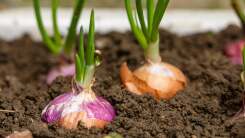As the crisp autumn breeze sweeps through the Appalachian hills, it’s time to embark on a journey of rejuvenation and growth. With an entrepreneurial family background deeply rooted in the soil, you understand the importance of strategic planning and maximizing your resources. So why not utilize this opportunity to plant vegetables that will flourish come spring? Let’s delve into the world of horticulture with a technical lexicon vocabulary and an emotional tone that resonates with our Appalachian heritage.
Nurture Nature’s Bounty: Selecting Ideal Vegetables for Fall Planting
In this season of transformation, selecting the right crops is crucial for ensuring a thriving garden next spring. Opt for cool-season vegetables like kale, spinach, and Swiss chard that can withstand frosty temperatures while still providing nourishment throughout winter. These resilient greens possess remarkable cold tolerance due to their ability to convert starches into natural antifreeze compounds.
Additionally, consider planting root vegetables such as carrots, beets, and radishes which thrive during cooler months. Their hardiness allows them to endure chilly conditions underground while developing robust flavors enhanced by nature’s chill.
To further diversify your garden bed, embrace legumes like peas or fava beans that fix nitrogen in the soil—nature’s own fertilizer! By harnessing these plants’ symbiotic relationship with beneficial bacteria called rhizobia, you’ll enrich your soil with essential nutrients necessary for future crops.
The Artistry of Timing: Sowing Seeds at Precise Intervals
Growing exceptional produce requires meticulous timing akin to orchestrating a symphony. To achieve optimal results when planting fall crops destined for spring harvests, it is vital to adhere to specific intervals between sowing seeds.
For instance, when planting kale or Swiss chard, aim to sow the seeds around six to eight weeks before the first expected frost. This timeframe allows these leafy greens ample time to establish themselves and develop sturdy roots that will anchor them through winter’s harsh embrace.
In contrast, root vegetables like carrots and beets require a slightly different approach. Sow their seeds approximately ten weeks before the first anticipated frost date. By doing so, you provide these underground wonders with sufficient time to mature into delectable delights while enduring colder temperatures.
Cultivating Resilience: Nurturing Your Fall Garden
A successful garden is not merely about sowing seeds; it requires dedication and nurturing throughout its lifecycle. As autumn transitions into winter, ensure your plants receive adequate protection from freezing temperatures by utilizing row covers or cold frames. These protective barriers shield your crops from icy winds while still allowing sunlight to penetrate and fuel their growth.
Remember to monitor soil moisture levels diligently during this period as well. While watering frequency may decrease due to cooler weather conditions, it remains crucial for maintaining healthy root systems. Strike a balance between providing enough hydration without overwatering—nature’s delicate dance of equilibrium.
Celebrating Nature’s Bounty: A Spring Harvest Worth Waiting For
As spring emerges from its wintry slumber, your patience and hard work will bear fruit—literally! Witnessing vibrant green shoots breaking through the thawed earth is an exhilarating experience that connects us deeply with our Appalachian heritage—a testament to our resilience as individuals and communities alike.
Your bountiful harvest of tender kale leaves, crisp radishes, succulent peas, and other delightful treasures will serve as a reminder of nature’s generosity—and your entrepreneurial spirit that transformed mere seeds into flourishing abundance. So, embrace the fall season as an opportunity to revitalize your garden and cultivate a future brimming with sustenance and pride.
